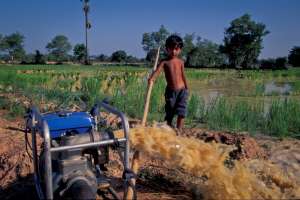
Striking rates of economic growth notwithstanding, 550 million people remain hungry in the Asia and Pacific region, 65% of the population has no safe piped water, and more than 600 million people live without electricity. Overcoming these problems requires a combined approach in which food, water and energy are treated as a nexus, rather than as separate, standalone issues, which has too often been the case in the past.
This is a tough task. While food, water, and energy are complex enough issues on their own, the interplay amongst them makes finding solutions even harder. For example, food and energy production requires massive amounts of water. Asia uses up to 80% of its water on agriculture at a time when demand from burgeoning cities is surging and water production, particularly for irrigation, is dependent on electricity and fuel. This, in turn, demands the construction of hydropower plants and large dams which alters river systems and farming productivity.
This web of trade-offs and interdependencies shapes our food, water, and energy outlook and should be dealt with early and directly, rather than as an afterthought. At the 14th Delhi Sustainable Development Summit in New Delhi in early February, 2014, ADB President Takehiko Nakao singled out the need for an integrated approach which considers the nexus that binds the three areas.
Current population, economic, and weather trends add to the tangle. Increasing populations and urbanization will use up more resources, particularly in Afghanistan, Malaysia, Nepal, Pakistan, Philippines and Timor-Leste, where populations are projected to double (or nearly so) by 2050. Rising inequality in countries which are home to 80% of Asia’s people also diminishes development gains, and makes progress highly uneven, leaving more people vulnerable to shocks.
The increasingly severe effects of climate change—particularly the climate-related disasters of 2013—make the likelihood of shocks more striking and evident. Recall that it was the poorest residents of Tacloban City in the Philippines who were left most helpless after Typhoon Haiyan hit, going for days and even weeks, without sufficient food, water, and energy.
The need for urgent and appropriate action was therefore the consensus of the Shell forum on the stress nexus held on 6 February, 2014, in Manila. Given the gargantuan task of ensuring food, water, and energy security, governments, with the help of the development community, must make difficult political decisions to achieve a more sustainable future.
At the national level, governments must strengthen price signals to ensure efficient and sustainable use of scarce resources. Removing subsidies which encourage the overuse of groundwater resources must be seriously considered, to be potentially replaced by incentives which encourage investments in energy efficiency and water saving technology. While groundwater irrigation has been instrumental in increasing agricultural productivity in South Asia and East Asia, the high extraction rates are no longer tenable. In Gujarat, India, groundwater tables are now dropping 6 meters per year. In the People’s Republic of China and Pakistan, more than 20% of irrigated lands are already affected by salinity.
Regional cooperation also offers solutions with high economic, social, and environmental impacts. Trans-border power transmission from Nepal, with its huge hydro energy potential, and to India, with its high energy demand, is a good example of cooperation at work. Likewise, by mid-2014, Bhutan’s Dagachhu Hydropower Plant will be exporting enough electricity to India to power 700,000–800,000 homes. Using this clean electricity will prevent some 500,000 tons of carbon dioxide emissions a year.
In addition, many water resources are a regional common good and can only be successfully managed within an integrated regional framework. Shared river systems among the South, Southeast and East Asian countries call for inclusive management with the burden of decision-making, governance, and action shared with the affected peoples.
Our earth is a common good. It provides the environment on which the food, water and energy nexus rests. Even with higher yielding, more resilient crop varieties, and water supply engineering feats—food, water, and energy security is only feasible in a thriving environment. We need healthy forests, mangroves, seas, rivers, clean air, and a stable environment to support life. Greenhouse gas emissions must be curbed and our bouts with extreme storms, precipitation and droughts in recent years should be our wakeup call. Conserving and rebuilding the environment is central not only to smoothing the complex interrelationships of food, water, and energy, but also to shoring up our economic foundations.
Rebuilding the environment and restoring the nexus should be higher on governments’ priority lists. The need to scale-up successful projects is critical since small players will hardly change the picture or alter the course of events. Bold moves are needed, and needed now.
This article was first published by the ADB Development Blog [1].